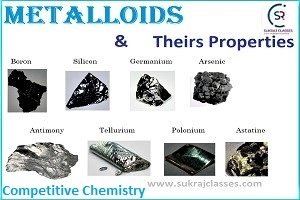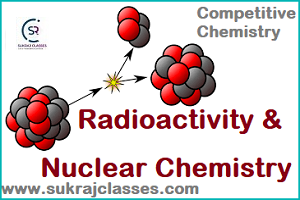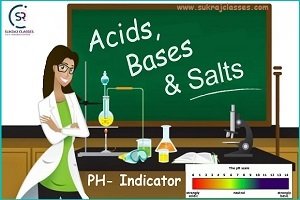
Non-Metals and Their Properties – Characteristics of Non-Metals
Chemistry topic – “Non-Metals and Their Properties – Characteristics of Non-Metals”, is important for all competitive exams like CET- Common eligibility Test, SSC CGL, SSC CHSL, RRB NTPC, UPSC and other state civil services exams. In these exams, almost 4-5 Questions are coming from Chemistry. Let’s start the topic:
Non-Metals and Their Properties:
Non-metals are the elements which form negative ions by gaining an electron. Thus, non-metals are also known as Electronegative Elements.
- Non-metals are the elements that do not conduct electricity and are neither malleable nor ductile.
- Non-metal may be solid, liquid or gas.
- Bromine is the only liquid non-metal.
- Examples: Carbon (C), Silicon (Si), Hydrogen (H), Oxygen (O).
Properties of Non-Metals:-
- Hardness: Non-metals are not hard rather they are generally soft. But the diamond is an exception; it is the hardest naturally occurring substance.
- State: Non-metals may be solid, liquid or gas.
- Lustre: Non-metals have a dull appearance. Diamond and iodine are exceptions.
- Sonority: Non-metals are not sonorous, i.e., they do not produce a typical sound on being hit.
- Conduction: Non-metals are a bad conductor of heat and electricity. Graphite which is allotrope of carbon is a good conductor of electricity and is an exception.
- Malleability and ductility: Non-metals are brittle.
- Melting and boiling point: Non-metals have generally low melting and boiling points.
- Density: Most of the non-metals have low density.
- Colour: Non-metals are in many colours.
Use of Non-Metals:-
- Oxygen is used for breathing.
- Chlorine is used for purifying water.
- Chlorine is also used in bleaching powder and liquid bleach, which are used for cleaning purposes.
- Phosphorous is used in crackers.
- Nitrogen is used in fertilizers.
- Graphite is used as a good conductor of electricity.
- Potassium is used in fertilizers.
- Nitrogen is used by plants.
- Graphite is used in making leads.
- Bromine is used in dyes and pesticides.
- Diamond is used in industries for cutting of glass, etc.
- Coal, another form of carbon, is used as a fuel.
- Iodine is used in the treatment of Goitre.
Important Non-metals:-
Carbon (C):
- Carbon occurs both in a free state as well as in the combined state.
- Carbon has two crystalline allotropes diamond and graphite.
- Carbon in the form of diamond is a non-metal which is extremely hard.
- Carbon in the form of graphite is non-metal which conduct electricity.
Allotropes of Carbon:
Diamond:
- Diamond is the hardest substance and is the bad conductor of electricity.
- Diamond is the purest form of the Carbon
- Used in the making of jewellery and cutting glass.
- Diamond is a non-metal which has a very high melting point and boiling point.
Graphite:
- Graphite is also a allotrope of carbon.
- Graphite is an exception. It is a good conductor of heat and electricity.
- Used in the nuclear reactor as a moderator.
Compounds of Carbon:
Carbon Monoxide (CO):
- It is colourless, odourless, neutral and highly poisonous gas in nature.
- CO (carbon-mono-oxide) has higher affinity with haemoglobin. Due to this property, CO forms Carboxyhaemoglobin when mix with haemoglobin which is a toxic substance and not able to absorb oxygen. Thus resultant, leads to suffocation and causing death.
- It is the reason, coal fire does not kept in a close room and slept.
Carbon Dioxide (CO2):
- Carbon dioxide is colourless gas.
- Carbon dioxide gas is the main responsible gas for global warming.
- Plants require carbon dioxide to conduct photosynthesis. CO2to sustain and increase the rate of plant growth.
- Solid CO2 is known as Dry ice.
- CO2 is used as fire extinguisher.
- The Earth’s atmosphere consists of 0.03% – 0.04% carbon dioxide
- CO2 gas is main responsible gas for air pollution which exhausted from automobiles industries chimneys and volcano etc.
- On heating of sodium bi-carbonate (NaHC – backing soda) it produce CO2 It is the reason that sodium bicarbonate use in bakery industries which makes bakery/bread bloated.
Oxygen (O):-
- Oxygen is a gas at room temperature.
- Oxygen is odourless, tasteless and colorless.
- Oxygen exists in two allotropic forms that are in the most stable diatomic form (O2) and in a less stable triatomic form (O3) ozone.
- Exists as two oxygen atoms bonded together – diatomic O2
- Oxygen is the 3rd most abundant element found in the universe.
- Oxygen is most abundant element present in our “earth-crust”.
- The most abundant element present in human body is oxygen.
- The Earth’s atmosphere consists of 21% oxygen.
- Most living organisms on Earth need to breathe oxygen to live.
- Oxygen is soluble in water. Hence, aquatic life is possible.
- Plants produce oxygen through a process known as photosynthesis.
- Ozone is an allotropic form of oxygen which form a layer in atmosphere, which absorb U.V. rays.
- Ozone is use in the sterilization process.
- Oxygen is the supporter of combustion but it is non-inflammable.
Nitrogen (N):
- Nitrogen is a gas that is colorless, odourless and tasteless.
- It is insoluble in water.
- Nitrogen is a gas at room temperature.
- It is a diatomic gas, N2.
- Dinitrogen (N2) is most abundantly present around 78% of the Earth’s atmosphere (in third layer).
- If there is no nitrogen in our atmosphere, our earth became to ash.
- Nitrogen gas provides an inert atmosphere on the earth.
- At the time of thundering, atmospheric nitrogen converted into nitrate, which improve the fertility of soil.
- Nitrogen is the fourth most abundant element found in the human body.
- The compound Nitrous oxide (N2o), also called nitrous or laughing gas, is used as Anaesthesia Substance by medical professionals.
- Nitrogen + Argon are filled in electric blub.
Phosphorus (P):
- Phosphorus is a highly reactive non-metal so, it does not occur in the Free State.
- Phosphorus is an essential constituent of bones, teeth, blood nerves and tissue.
- Bones contain approx. 80% phosphorus.
Sulphur(S):
- Sulphur occurs in the free-state in volcanic areas.
- Sulphur is used in the rubber industry for vulcanization of rubber.
- Sulphur exists in five allotropic forms.
Chlorine (Cl):
- Chlorine is always present in the combined state in nature in the form of chlorides.
- Chlorine is used as a bleaching agent.
- It is used as a disinfectant and oxidizing agent.
Iodine (I):
- Iodine is non-metal which is lustrous having a shining surface.
- It is used as an antiseptic as tincture of Iodine.
- Iodine is used in the treatment of Goitre.
- Turns starch solution blue.
Non-Metals and Their Properties – Characteristics of Non-Metals
For More:
If you like and think that General Science (Chemistry) topic on “Non-Metals and Their Properties – Characteristics of Non-Metals” was helpful for you, Please comment us. Your comments/suggestions would be greatly appreciated. Thank you to be here. Regards – Team SukRaj Classes.





